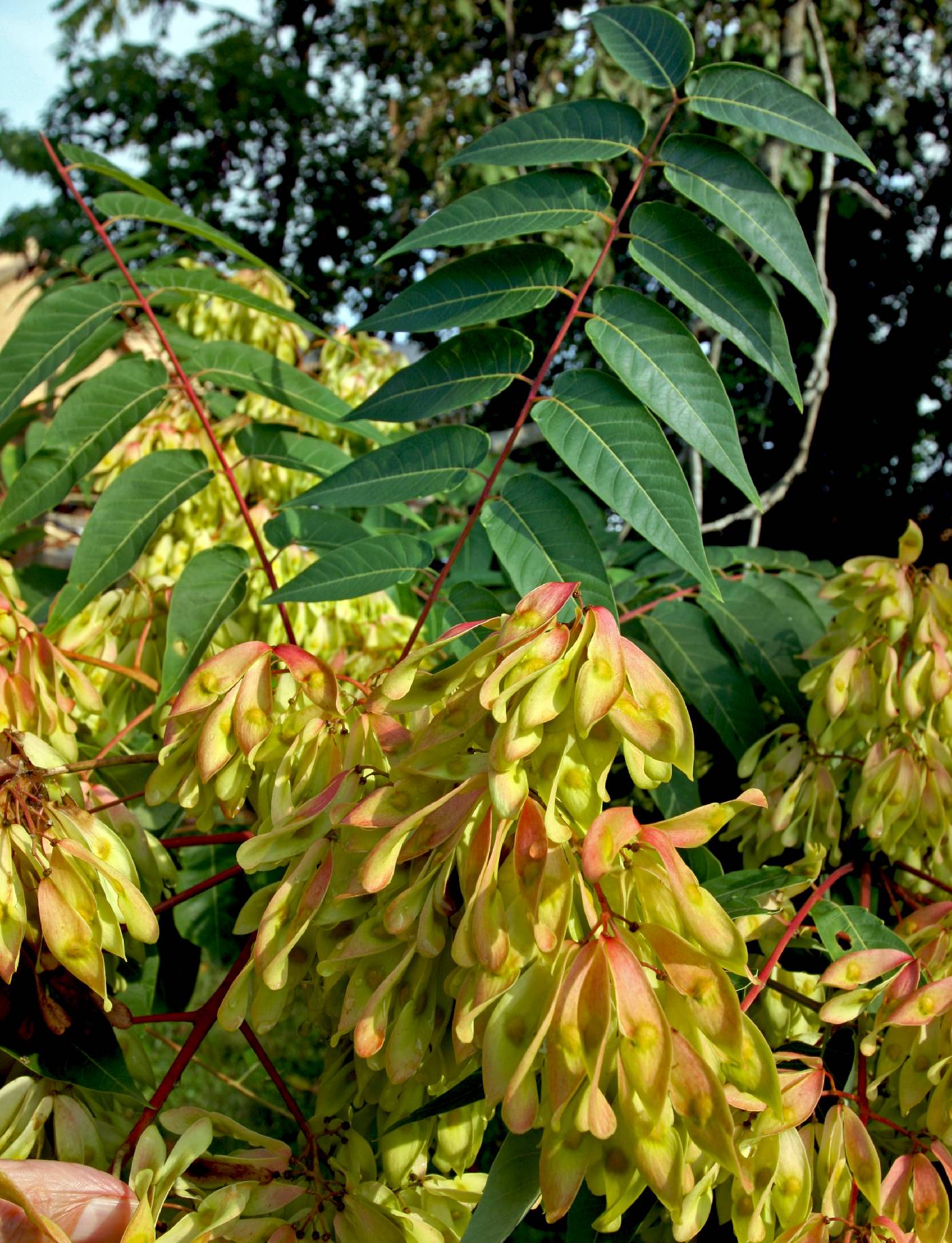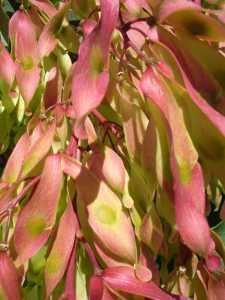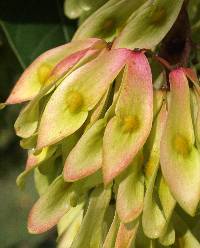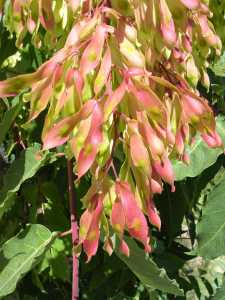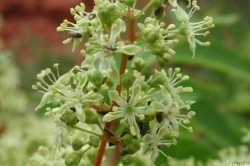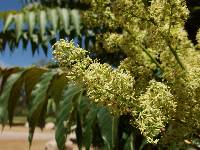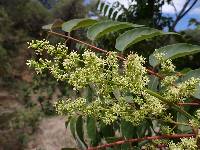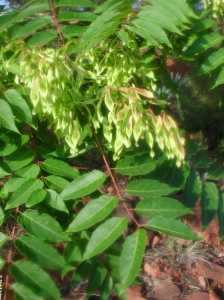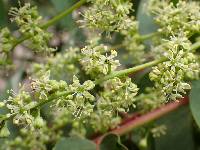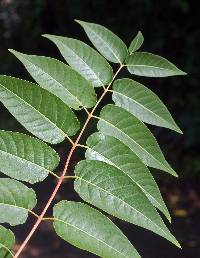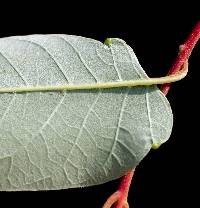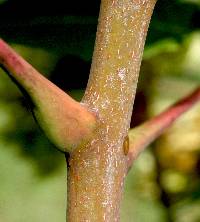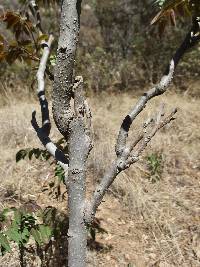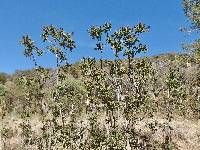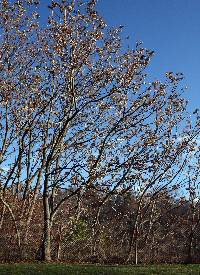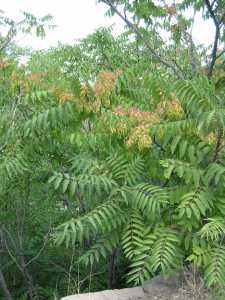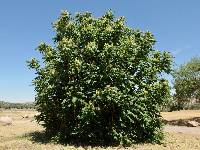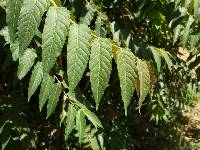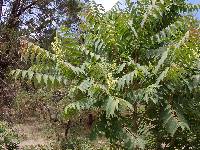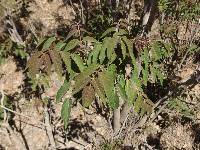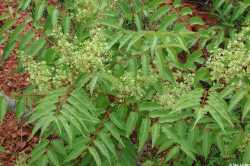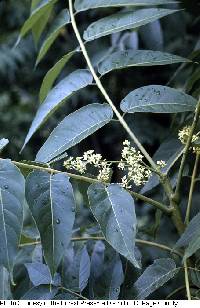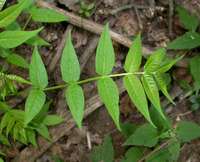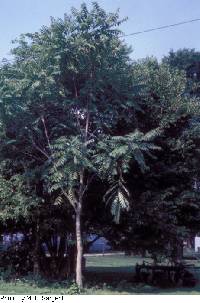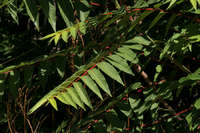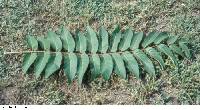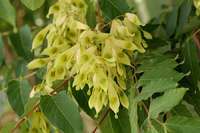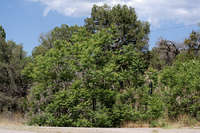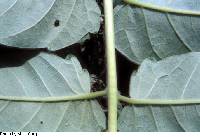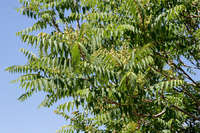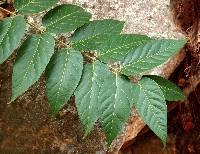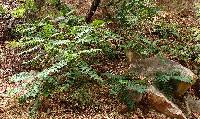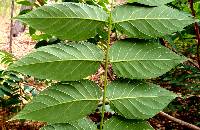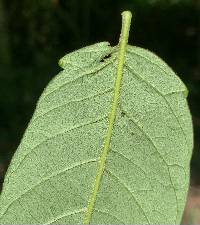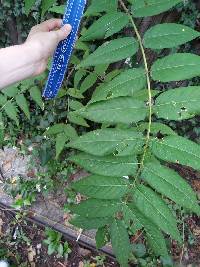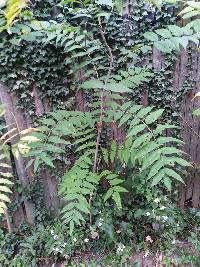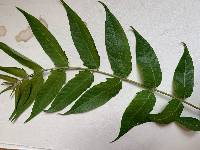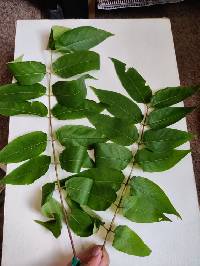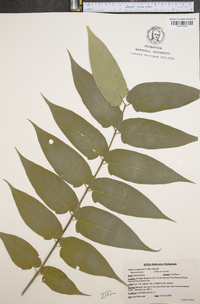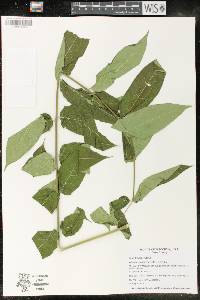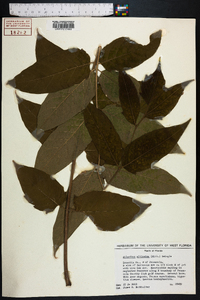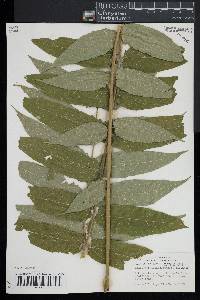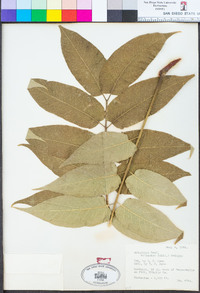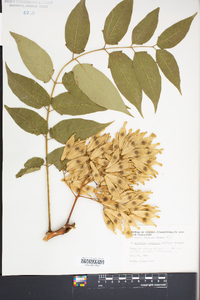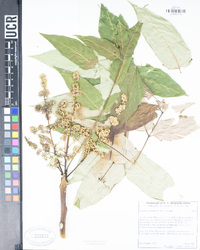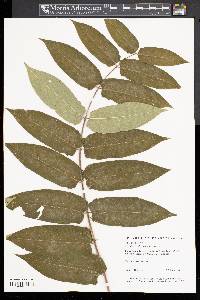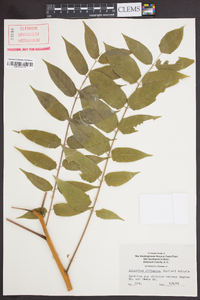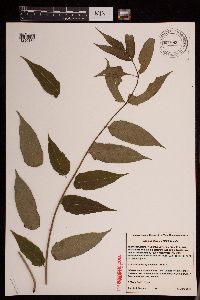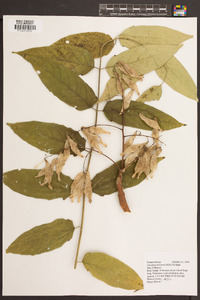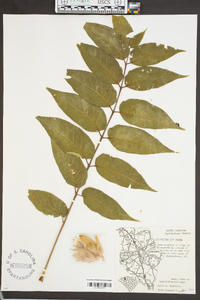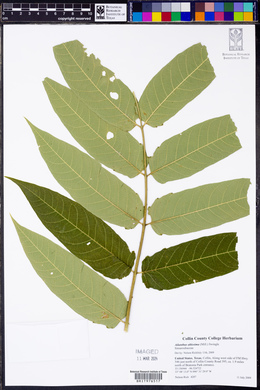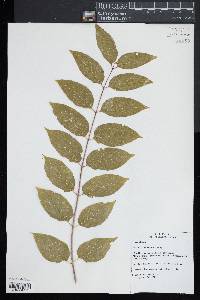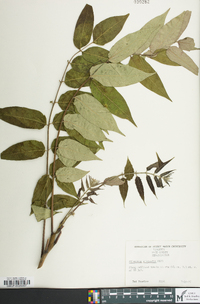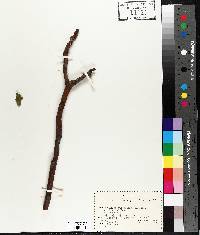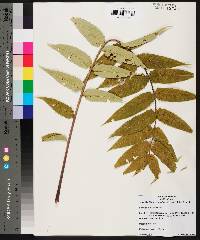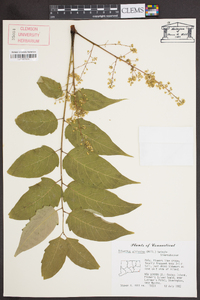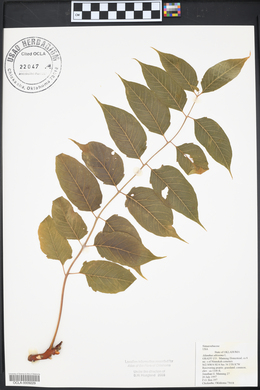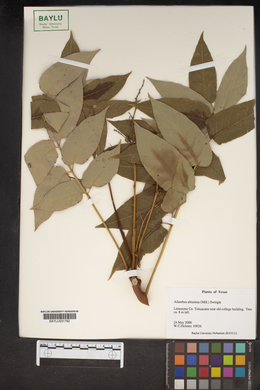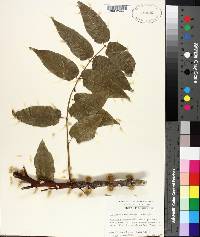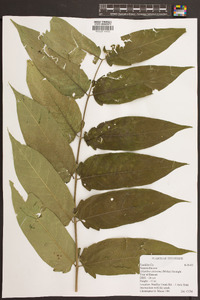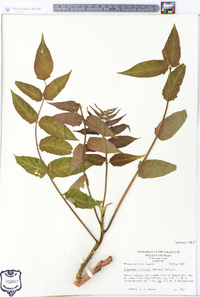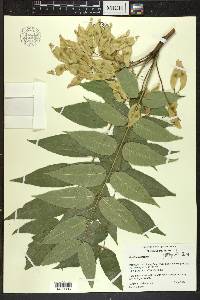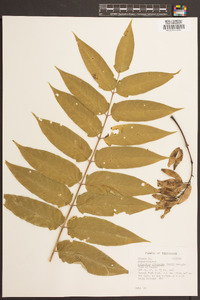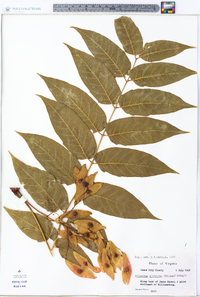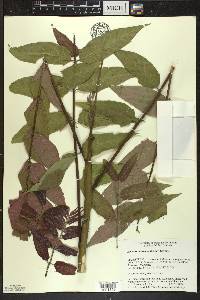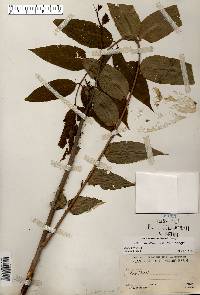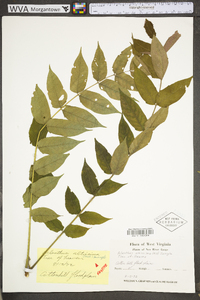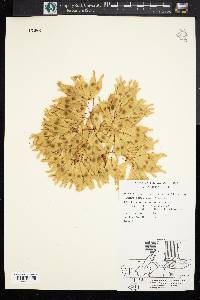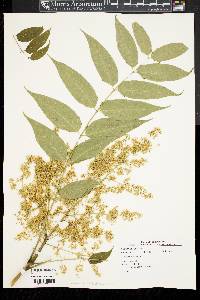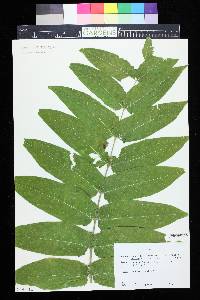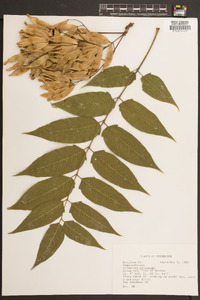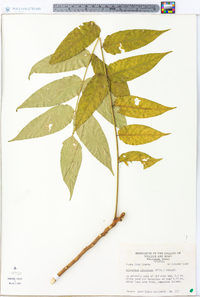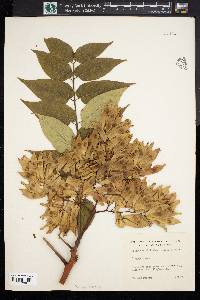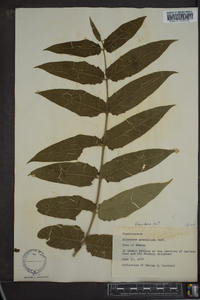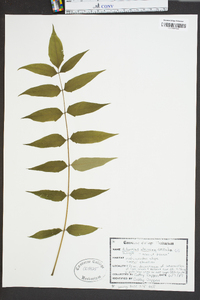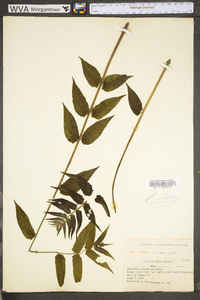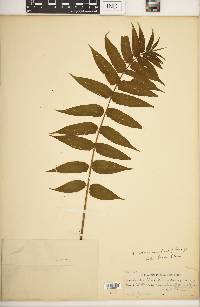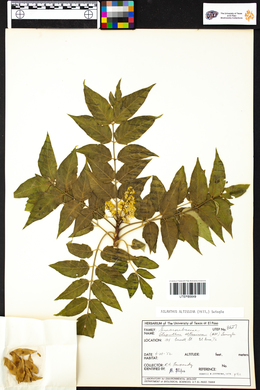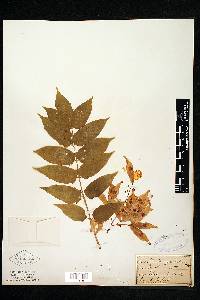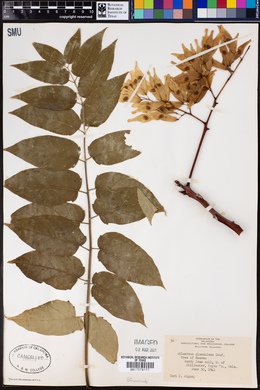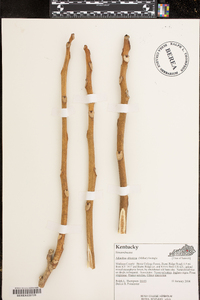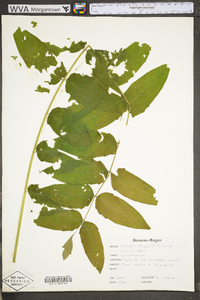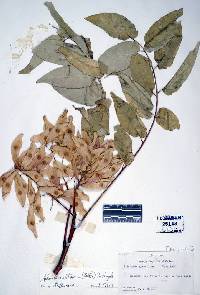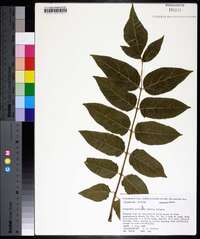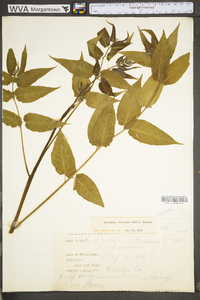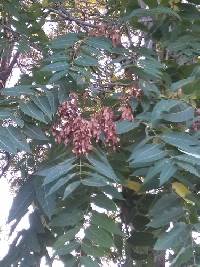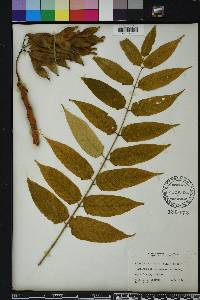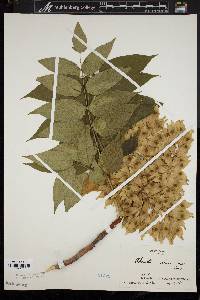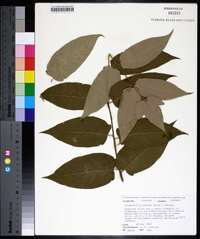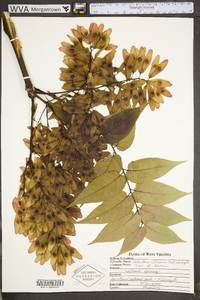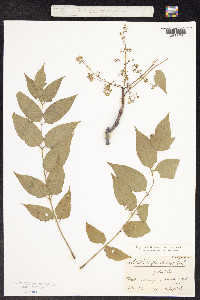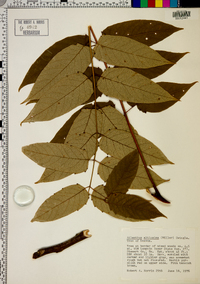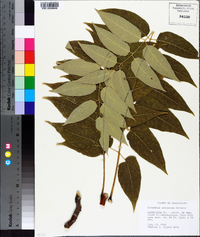
|
|
|
|
Family: Simaroubaceae
Tree-of-Heaven, more...ailanthus, copal tree, tree of heaven (es: nogal)
[Ailanthus giraldii, moreAilanthus glandulosa Desf.] |
Plant: tree; rapidly growing tree to 20 m tall, sometimes producing clonal thickets via rhizomes; young parts more or less glandular-puberulent; bark smooth; wood soft, brittle, with a broad pith Leaves: (1-)3-10 dm long; leaflets 9-31, (5-)8-15 cm long, lanceolate, with (1-)2-4(-6) large glands on the margin below, these situated near the base, terminating a small tooth or lobe INFLORESCENCE: a large terminal panicle, 1-4 dm long Flowers: small, greenish to whitish; calyx less than 1 mm long; petals 2-3 mm long, woolly on and near the proximal margins; filaments pubescent basally; disk lobed; ovary with 2-5 flat 1-carpellate divisions Fruit: samaras, 3-5 cm long, linear, curved or oblique at the base, twisted 1/2 turn at the apex; seed-bearing portion near the center, 3-7 mm wide Misc: near buildings, roads, streams, and washes; at least 350-1700 m (1100-5500 ft); Apr-Jun REFERENCES: Brasher, Jeffrey W. 1999. Simaroubaceae. Ariz. - Nev. Acad. Sci. 32(1). Tree to 25 m tall Leaves: pinnately compound, up to 1 m long, with eleven to 41 leaflets. Flowers: either male or female, usually found on separate trees (dioecious), borne on a terminal inflorescence 10 - 30 cm long, yellowish green, tiny. The male flowers are unpleasantly scented, but the female flowers are odorless. Fruit: winged with a single seed in the center (samara), yellowish green to orangish red, 3 - 5 cm long, 7 - 13 mm wide and twisted. Bark: gray with thin, light vertical streaks. Twigs: stout, yellowish to reddish brown, covered with velvety hairs. Buds: reddish brown, very small, hairy. Terminal buds absent. Leaf scars: very large and heart-shaped. Leaflets: red to purplish when emerging, becoming dark green, narrow egg-shaped with a squared base, non-toothed except for one to four teeth near the base, usually with a gland on the underside of each tooth. Odor: strong, unpleasant when twigs and leaves crushed. Similar species: Ailanthus altissima may be mistaken for the native species Rhus typhina as both have large pinnately compound leaves. Rhus typhina has upright, pyramidal clusters of spherical, red, hairy fruits; leaflets with regularly toothed margins; and yellow, orange and red fall color. Flowering: mid June to mid July Habitat and ecology: Adaptable to very poor soils and pollution, this species is often found in industrial and commercial areas, older residential areas, alleys, between buildings, along walls, around dumps, along streams, and in disturbed natural areas. Occurence in the Chicago region: non-native Notes: Ailanthus altissima was introduced as a landscape tree in the 1780s and has become invasive. It is capable of growing in the poorest of soils, and its root system is strong enough to damage foundations and sewers. A single plant of this invasive species produces up to 325,000 seeds per year. It also spreads by root sprouts, and is capable of growing over 1.5 m per year. To prevent invasion of its territory, A. altissima emits toxins that kill other plant species. Etymology: Ailanthus comes from the Moluccan name for this tree. Altissima comes from the Latin words meaning "very tall." Author: The Morton Arboretum Martin and Hutchins 1980, Carter 2012, Heil et al 2013, Heisy 1997. Common Name: tree of heaven Duration: Perennial Nativity: Non-Native Lifeform: Tree Wetland Status: FACU General: Weedy, introduced tree, from rapidly growing rhizomes, reaches 15 m in only 25 years. Often grows as clonal thickets. Trunks slender, bark smooth and light gray, often becoming rougher with light tan fissures. Leaves: Large, odd or even pinnately compound, arranged alternately on stem, glandular-puperulent, from 30-90 cm in length with 10-41 leaflets in pairs, largest leaves found on vigorous young sprouts. Rachis is light to reddish green with swollen base. Leaflets are ovate-lanceolate with entire margins. Flowers: Dioecious, but occasionally with a few perfect flowers; flowers are small, appear in terminal panicles up to 50 cm long, light yellowish green, five petals, 2-3 mm long with wooly proximal margins, and 5 sepals, less than 1 mm long. Staminate flowers malodorous. Fruits: Samara, twisted at tips, to aid in wind dispersal, 2.5 cm long, 1 cm broad, reddish to straw colored. Ecology: Found widespread in US, highly invasive. In the Southwest it is found along irrigation ditches and floodplains, and occasionally at old homesteads, roadsides and vacant lots at the lower and middle elevations; flowers April-July. Distribution: Native to China and introduced throughout the world. Most of N. Amer. except western CAN and some of the n US; south to c MEX. Ethnobotany: Used in China as an insect repellent, wood can be used for cabinetry, and the dried bark is a listed Chinese medicine. Some treatments listed as antimalarial agent, for cardiac palpitation, asthma, and epilepsy. Extract has a potential modern use as an organic herbicide. Etymology: Ailanthus is form a Moluccan name ailanto meaning -sky tree-, while altissima means very tallest. Synonyms: Ailanthus glandulosa Editor: SBuckley 2010, FSCoburn 2015, AHazelton 2015 Rapidly growing tree with few branches and coarse twigs; lvs large, to 1 m; lfls 11-41 (the terminal one often imperfectly developed or wanting), narrowly oblong, entire except for one or more coarse teeth near the base, each tooth with a large gland beneath; infl pyramidal, 1-3 dm; fls greenish or greenish-yellow, 5 mm wide; frs 3-5 cm 7-13 mm, twisted; 2n=80. Native of e. Asia, often escaped from cult. in our range, especially in cities. (A. glandulosa) Gleason, Henry A. & Cronquist, Arthur J. 1991. Manual of vascular plants of northeastern United States and adjacent Canada. lxxv + 910 pp. ©The New York Botanical Garden. All rights reserved. Used by permission. From Flora of Indiana (1940) by Charles C. Deam In waste places in cities and towns, in a few places in woodland in southern Indiana, and along the wooded bluffs of the Ohio River, especially in Jefferson County. ...... Indiana Coefficient of Conservatism: C = null, non-native Wetland Indicator Status: FACU Diagnotic Traits: Tree with unpleasant smell from crushed foliage; leaves alternate, pinnately compound; leaflets numerous, their bases with 1-2 blunt teeth that bear a gland on the lower surface; samara fruits thin and oblong. Deam (1932): [Note - for this species, the recommendation from 1932 to plant Ailanthus is highly questionable]. Where the sugar and black maples can not be used for shade tree planting this tree should receive attention. It adapts itself to all kinds of soil, and to all kinds of growing conditions such as smoke, etc. The crown is of an oval or rounded type. It stands pruning and injury to trunk or branches very well. It is practically free from all diseases and insect injury. The leaves appear late but they do not fall until the first killing frost when they are killed, and frequently practically all of the leaves will fall in one day. The staminate flowers exhale a fetid odor for a few days which is about the only objectionable feature in this tree. In order to obviate this objection, nurserymen are now offering for sale pistillate trees which have been grafted on common stock. However, I think these more objectionable because their seed scatter widely and they come up everywhere, making the tree a neighborhood nuisance. Cattle eat the leaves with a relish. |
|
|
|

